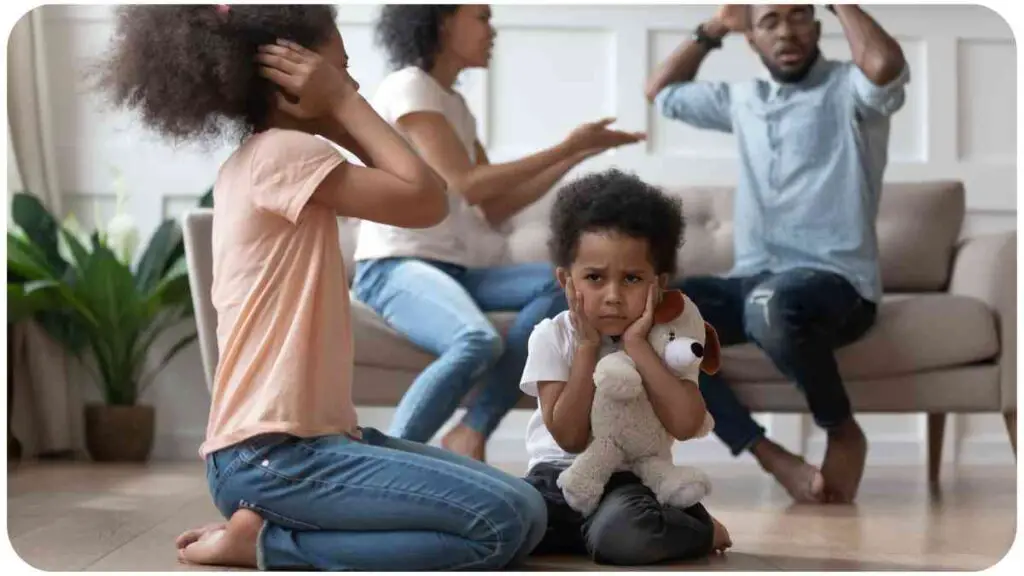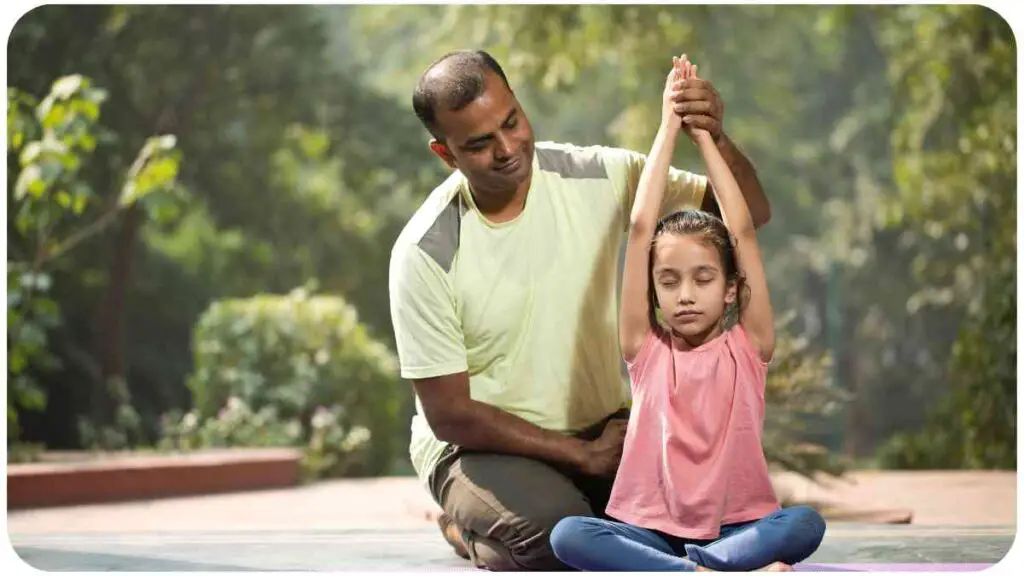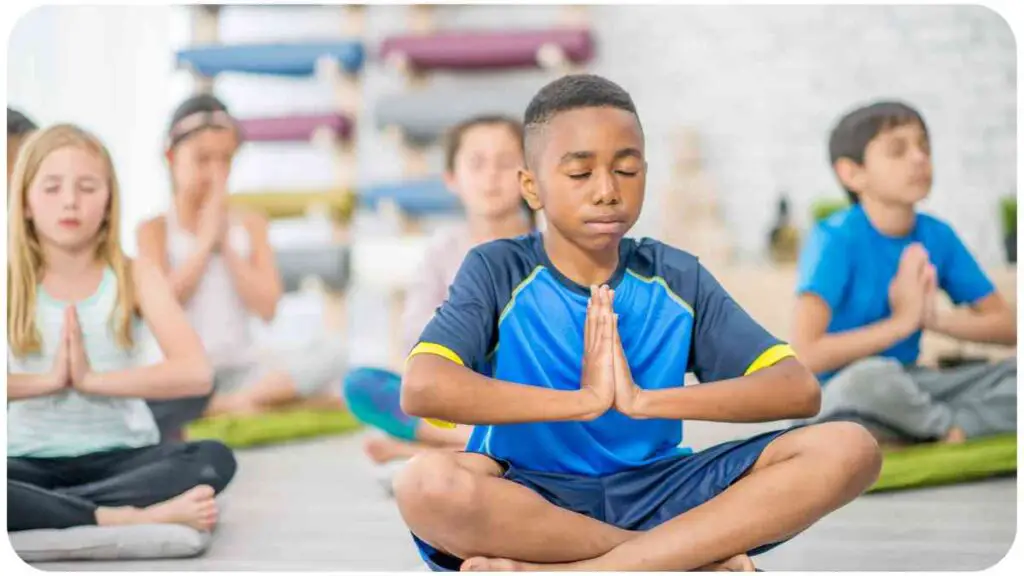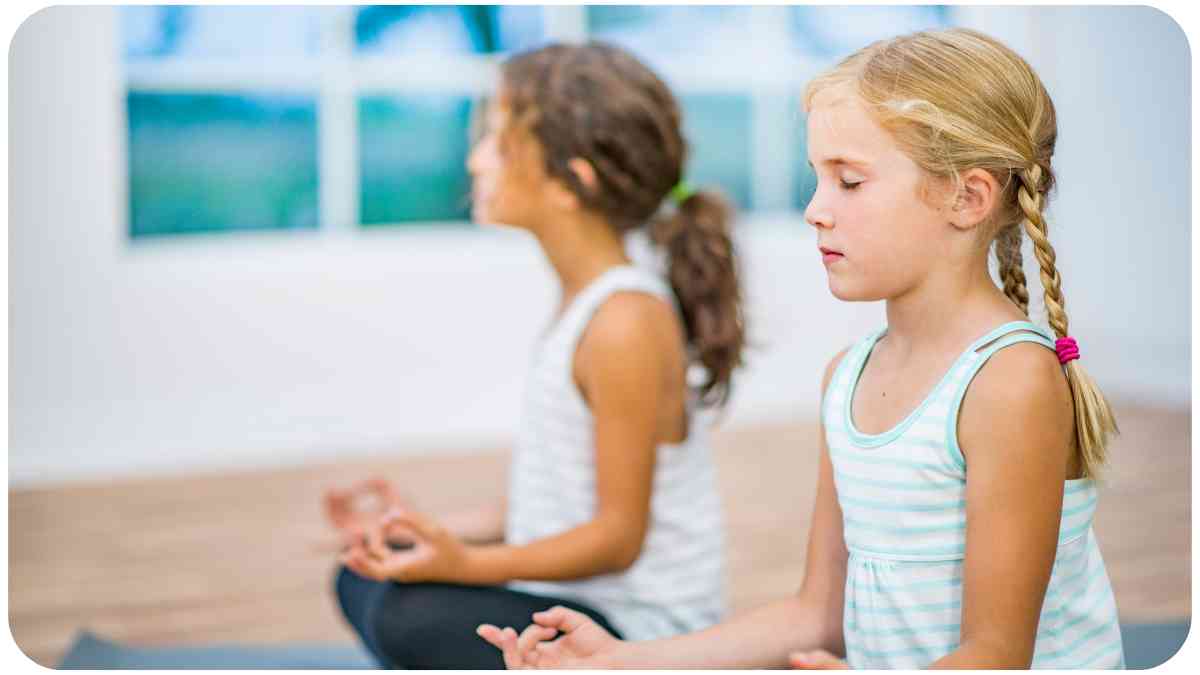Childhood anxiety is a prevalent concern that often goes unnoticed. As a parent or caregiver, it’s crucial to recognize the signs and explore effective strategies to support anxious kids.
This article delves into the world of guided meditations, offering insights, practical tips, and real-life success stories to help your child overcome anxiety.
| Takeaways |
|---|
| 1. Guided meditation can be a powerful tool to alleviate anxiety in children. |
| 2. Creating a conducive environment and choosing age-appropriate meditations are key to successful implementation. |
| 3. Consistency in practicing guided meditation fosters its effectiveness in improving focus, emotional regulation, and sleep patterns. |
| 4. Real-life success stories highlight the positive impact of guided meditation on children’s well-being. |
| 5. Expert tips from child psychologists provide valuable insights for parents and caregivers. |
| 6. Additional resources, including apps, books, and online communities, offer further support for parents navigating childhood anxiety. |
| 7. Frequently asked questions provide practical answers for common concerns related to guided meditation for anxious kids. |
| 8. The journey starts with a proactive commitment to integrating guided meditation into a child’s daily routine. |
2. Understanding Childhood Anxiety
Before we explore relaxation techniques, let’s grasp the fundamentals of childhood anxiety. What triggers it, and how does it manifest in kids? Understanding these aspects lays the groundwork for effective interventions.
Discover the profound impact of mindfulness on mental health. Explore the science behind mindfulness and unlock the potential for improved well-being and emotional balance.
Table 2.1: Common Signs of Childhood Anxiety
| Signs | Description |
|---|---|
| Excessive Worrying | Persistent, uncontrollable fears or concerns |
| Physical Symptoms | Headaches, stomachaches, muscle tension |
| Changes in Behavior | Irritability, restlessness, avoidance |
| Sleep Disturbances | Trouble falling asleep or frequent nightmares |
Table 2.2: Factors Contributing to Childhood Anxiety
| Factors | Impact |
|---|---|
| Genetics | Predisposition to anxiety disorders |
| Environmental Stressors | Family issues, school pressures, etc. |
| Traumatic Experiences | Past events influencing present anxiety |
3. Impact of Anxiety on Kids

The repercussions of childhood anxiety extend beyond the emotional realm, affecting various aspects of a child’s life. Understanding the impact helps emphasize the urgency of addressing anxiety with effective techniques.
Table 3.1: Effects of Anxiety on Children
| Aspect | Impact |
|---|---|
| Academic Performance | Difficulty concentrating and learning |
| Social Relationships | Struggles in making and maintaining friends |
| Physical Health | Increased vulnerability to illnesses |
| Self-Esteem | Negative impact on confidence and self-worth |
4. The Importance of Relaxation Techniques
Relaxation techniques play a pivotal role in managing childhood anxiety. They offer a proactive approach, empowering kids to navigate their emotions and build resilience. Let’s delve into why incorporating relaxation techniques is crucial.
Dive into the nuanced differences between mindfulness and meditation. Uncover insights on mindfulness vs meditation to tailor your practice for enhanced relaxation and mental clarity.
Table 4.1: Benefits of Relaxation Techniques for Kids
| Benefit | Description |
|---|---|
| Stress Reduction | Alleviates tension and promotes calmness |
| Emotional Regulation | Helps children recognize and control emotions |
| Improved Focus and Attention | Enhances concentration and cognitive abilities |
| Better Sleep Patterns | Facilitates restful and quality sleep |
5. Guided Meditation: A Powerful Tool

Guided meditation emerges as a powerful and accessible tool for calming anxious minds. It involves a structured process led by a narrator, facilitating a sensory experience that promotes relaxation. Let’s explore why guided meditation is particularly effective for kids.
Table 5.1: Key Elements of Guided Meditation for Kids
| Element | Description |
|---|---|
| Soothing Narration | Calming voice guiding the meditation process |
| Imaginative Visualization | Encourages creative and calming mental imagery |
| Simple Breathing Exercises | Teaches controlled and mindful breathing |
| Age-Appropriate Themes | Tailored to engage children’s interests |
6. How to Introduce Guided Meditation to Kids
Now that we understand the significance of guided meditation, let’s explore practical ways to introduce this technique to anxious children. Making the experience enjoyable and accessible is key to its success.
Ease children into peaceful sleep with calming nightly meditations. Learn how calming nightly meditations can create a soothing bedtime routine, promoting restful sleep for young minds
6.1 Setting the Right Environment
Creating a conducive environment sets the stage for successful guided meditation sessions. Consider factors like lighting, comfortable seating, and minimizing distractions.
Table 6.1: Creating the Perfect Meditation Environment
| Element | Description |
|---|---|
| Quiet Space | Choose a calm area free from loud distractions |
| Comfortable Seating | Use cushions or mats for a relaxed sitting |
| Soft Lighting | Dim lights to promote a soothing atmosphere |
| Distraction-Free Zone | Keep away toys or electronic devices |
6.2 Choosing Appropriate Guided Meditations
Not all guided meditations are created equal. Tailoring the sessions to your child’s age, interests, and attention span ensures engagement and effectiveness.
Table 6.2: Factors to Consider When Choosing Guided Meditations
| Factor | Description |
|---|---|
| Age Suitability | Select meditations designed for specific age groups |
| Engaging Themes | Choose topics aligned with your child’s interests |
| Duration | Start with shorter sessions, gradually increasing |
6.3 Incorporating Visualization Techniques
Guided meditations often involve visualization exercises. These techniques stimulate a child’s imagination, fostering relaxation and mindfulness.
Ignite creativity in kid yogis with imaginative visualizations. Explore the wonders of creative visualizations for kid yogis, guiding them from the new moon to a realm of relaxation and self-discovery.
Table 6.3: Visualization Techniques for Kids
| Technique | Description |
|---|---|
| Imaginary Journeys | Guiding children through calming mental imagery |
| Nature Exploration | Encouraging visualization of serene natural settings |
| Storytelling | Incorporating narrative elements for engagement |
6.4 Encouraging Consistency
Consistency is key when introducing any new practice. Establishing a routine for guided meditation helps integrate it seamlessly into your child’s daily life.
Table 6.4: Establishing a Guided Meditation Routine
| Routine Element | Description |
|---|---|
| Regular Timing | Choose a consistent time each day for meditation |
| Positive Reinforcement | Acknowledge and reward your child’s participation |
| Family Involvement | Make it a shared activity for added motivation |
7. Benefits of Guided Meditation for Anxious Kids

The advantages of incorporating guided meditation into a child’s routine are multifaceted. Let’s explore the specific benefits that contribute to alleviating anxiety and promoting overall well-being.
7.1 Improved Focus and Concentration
Guided meditation teaches children to direct their attention inward, enhancing their ability to concentrate on tasks and navigate challenges with a clear mind.
Encourage playful yoga flows for kids without the need for mats. Engage in easy no-mat kids yoga flows to foster physical activity and mindfulness, making yoga accessible and enjoyable for young ones.
Table 7.1: How Guided Meditation Enhances Focus
| Aspect | Impact |
|---|---|
| Mindful Awareness | Cultivates an awareness of the present moment |
| Reduced Distractions | Improved ability to ignore external disturbances |
| Enhanced Cognitive Skills | Supports better problem-solving and decision-making |
7.2 Reduced Physical Symptoms of Anxiety
Anxiety often manifests physically in children. Guided meditation helps alleviate these symptoms by promoting relaxation and reducing physiological stress responses.
Table 7.2: Physical Benefits of Guided Meditation
| Benefit | Description |
|---|---|
| Lowered Muscle Tension | Eases physical tension associated with anxiety |
| Decreased Heart Rate | Promotes a calmer cardiovascular response |
| Improved Respiratory Function | Encourages controlled and calm breathing |
7.3 Enhanced Emotional Regulation
One of the core benefits of guided meditation is its impact on emotional regulation. Children learn to identify and manage their emotions, fostering a healthier emotional landscape.
Table 7.3: Emotional Regulation through Guided Meditation
| Skill Developed | Description |
|---|---|
| Increased Self-Awareness | Recognizing and understanding one’s emotions |
| Stress Reduction | Effectively coping with stressors |
| Emotional Resilience | Building the ability to bounce back from challenges |
7.4 Better Sleep Patterns
Quality sleep is crucial for a child’s overall well-being. Guided meditation helps create a serene bedtime routine, promoting restful and uninterrupted sleep.
Table 7.4: How Guided Meditation Contributes to Better Sleep
| Sleep Benefit | Description |
|---|---|
| Relaxation before Bed | Calming the mind for a peaceful transition to sleep |
| Reduced Nightmares | Diminishing the occurrence of distressing dreams |
| Establishing Bedtime Routine | Creating a consistent and calming pre-sleep ritual |
8. Addressing Common Concerns
As with any new practice, introducing guided meditation to anxious children might come with challenges. Addressing these concerns proactively ensures a smoother and more successful integration into their daily routine.
8.1 Age-Appropriate Meditations
Tailoring guided meditations to your child’s age is crucial for engagement and comprehension. Addressing age-specific concerns through these sessions is key to their effectiveness.
Table 8.1: Tips for Age-Appropriate Guided Meditations
| Consideration | Description |
|---|---|
| Simple Language | Use age-appropriate vocabulary and explanations |
| Shorter Durations | Begin with shorter sessions for younger children |
| Interactive Elements | Incorporate activities to maintain interest |
| Visual Aids | Use visual cues or props for better understanding |
8.2 Dealing with Resistance
Children may initially resist the idea of guided meditation. Understanding their concerns and employing strategies to make it enjoyable can overcome this resistance.
Table 8.2: Overcoming Resistance to Guided Meditation
| Strategy | Description |
|---|---|
| Incorporate Fun Elements | Make sessions interactive and enjoyable |
| Explain the Benefits | Discuss how meditation helps with anxiety |
| Lead by Example | Practice meditation together as a family |
| Offer Choices | Allow your child to choose meditation themes |
8.3 Integrating Meditation into Daily Routine
Finding the right time to incorporate guided meditation into your child’s day can be a challenge. However, integrating it seamlessly into their routine enhances its effectiveness.
Table 8.3: Tips for Integrating Meditation into Daily Life
| Integration Tip | Description |
|---|---|
| Choose Consistent Time | Establish a specific time for daily meditation |
| Combine with Activities | Integrate meditation into bedtime or playtime |
| Create Rituals | Develop a routine around meditation sessions |
| Encourage Independence | Teach older children to initiate sessions alone |
8.4 Monitoring Progress
Monitoring your child’s progress with guided meditation allows you to adapt and refine the approach. Regular assessment ensures that the technique remains beneficial.
Table 8.4: Ways to Monitor Progress with Guided Meditation
| Monitoring Method | Description |
|---|---|
| Observational Feedback | Note changes in behavior and emotional well-being |
| Encourage Open Dialogue | Foster communication about their meditation experience |
| Track Sleep Patterns | Monitor improvements in sleep quality and duration |
| Collaborate with Experts | Consult with child psychologists for additional insights |
9. Success Stories: Real-Life Experiences
Real-life success stories highlight the transformative power of guided meditation for anxious kids. These stories serve as inspirations for parents and caregivers navigating similar challenges.
9.1 Jenny’s Journey with Guided Meditation
Jenny, a 10-year-old struggling with school-related anxiety, found solace in guided meditation. Her mother introduced short sessions before homework, gradually extending them. Over time, Jenny’s concentration improved, and her stress levels diminished, leading to better academic performance.
Table 9.1: Jenny’s Guided Meditation Success
| Challenge | Solution |
|---|---|
| School-related Anxiety | Short, focused meditations before homework |
| Gradual Introduction | Incrementally increased meditation duration |
| Improved Concentration | Notable enhancement in academic focus |
| Enhanced Stress Coping | Better ability to manage school-related stress |
9.2 Mark’s Remarkable Transformation
Mark, a 7-year-old with generalized anxiety, underwent a remarkable transformation with guided meditation. His parents integrated sessions into daily routines, and Mark’s anxiety significantly decreased. He learned to identify and manage his emotions, leading to a happier and more resilient child.
Table 9.2: Mark’s Guided Meditation Success
| Challenge | Solution |
|---|---|
| Generalized Anxiety | Regular guided meditation integrated into daily routines |
| Emotional Regulation | Mark developed skills to manage and express his emotions |
| Improved Resilience | Noticed increased ability to bounce back from challenges |
| Happier and Calmer Child | Overall positive impact on Mark’s well-being |
9.3 Sarah’s Story of Overcoming Anxiety
Sarah, a teenager facing social anxiety, discovered the power of guided meditation through a school program. Consistent practice helped her cope with social situations, reduce anxiety levels, and build confidence in her interactions with peers.
Table 9.3: Sarah’s Guided Meditation Success
| Challenge | Solution |
|---|---|
| Social Anxiety | Introduced through a school-based meditation program |
| Consistent Practice | Regular sessions to manage social anxiety |
| Confidence Building | Noticed increased self-assurance in social interactions |
| Reduced Social Anxiety | Significant decrease in anxiety levels during social situations |
10. Expert Insights: Tips from Child Psychologists
Expert insights provide valuable guidance for parents and caregivers seeking effective strategies. Let’s explore tips from renowned child psychologists to enhance the implementation of guided meditation for anxious kids.
10.1 Dr. Emily Anderson on Child Anxiety
Dr. Anderson suggests:
“Understanding the unique needs of each child is crucial. Tailoring guided meditations to their preferences and addressing specific anxiety triggers fosters a more personalized and effective approach.”
Table 10.1: Dr. Anderson’s Tips
| Tip | Description |
|---|---|
| Personalization | Customize meditations based on individual preferences |
| Identify Triggers | Pinpoint specific anxiety triggers for targeted sessions |
| Encourage Open Dialogue | Foster communication to understand your child’s needs |
| Consistency is Key | Regularity in meditation practice enhances effectiveness |
10.2 Tips from Dr. Michael Harris
Dr. Harris emphasizes:
“Incorporating guided meditation into daily routines, such as before bedtime or after school, helps establish consistency. This routine becomes a reliable anchor for anxious children.”
Table 10.2: Dr. Harris’s Tips
| Tip | Description |
|---|---|
| Routine Integration | Embed meditation into existing daily routines |
| Anchor for Anxious Kids | Establishing a reliable and comforting routine |
| Parental Involvement | Engage in meditation together for added support |
| Monitor and Adapt | Regularly assess and adapt the meditation approach |
10.3 Insights from Dr. Lisa Rodriguez
Dr. Rodriguez advises:
“Visualization is a powerful tool for young minds. Incorporating guided meditations that involve imaginative journeys and creative visualizations can enhance the effectiveness of the practice.”
Table 10.3: Dr. Rodriguez’s Tips
| Tip | Description |
|---|---|
| Embrace Imagination | Utilize creative and imaginative visualization techniques |
| Age-Appropriate Themes | Select themes that resonate with the child’s interests |
| Encourage Creativity | Foster a sense of play and creativity during sessions |
| Gradual Progression | Introduce more complex visualizations as children become comfortable |
10.4 Dr. James Thompson’s Perspective
Dr. Thompson suggests:
“Consistency and positive reinforcement are key components in guiding anxious children towards successful meditation practices. Celebrate small victories and maintain a supportive environment.”
Table 10.4: Dr. Thompson’s Tips
| Tip | Description |
|---|---|
| Celebrate Small Wins | Acknowledge and celebrate progress, no matter how small |
| Positive Reinforcement | Encourage through positive affirmations and rewards |
| Create a Supportive Space | Ensure the meditation environment is comforting and supportive |
| Patience and Persistence | Understand that results may take time; be patient and persistent |
11. Additional Resources for Parents
Navigating the world of guided meditation for anxious kids can be aided by additional resources. Here are some recommended tools and platforms to further support parents and caregivers in fostering a positive environment for their children.
11.1 Recommended Guided Meditation Apps
Table 11.1: Top Guided Meditation Apps for Kids
| App | Description |
|---|---|
| Calm Kids | Offers age-appropriate meditations and sleep stories |
| Headspace for Kids | Provides guided exercises to promote mindfulness |
| Smiling Mind | Tailored programs designed for different age groups |
| Breethe Kids | Features calming music, bedtime stories, and meditations |
11.2 Books on Child Anxiety and Meditation
Table 11.2: Must-Read Books for Parents
| Book | Author |
|---|---|
| “The Whole-Brain Child” | Daniel J. Siegel, Tina Payne Bryson |
| “Sitting Still Like a Frog” | Eline Snel |
| “Anxious Kids, Anxious Parents” | Reid Wilson, Lynn Lyons |
| “Planting Seeds: Practicing Mindfulness with Children” | Thich Nhat Hanh |
11.3 Online Communities for Parents
Table 11.3: Supportive Online Communities
| Community | Description |
|---|---|
| Child Anxiety Network | Forum for parents dealing with child anxiety |
| Parenting and Mental Health Subreddit | Online space for sharing experiences and tips |
| The Anxious Child Facebook Group | Supportive community for parents of anxious kids |
| Mindful Parenting Community | Discussions on incorporating mindfulness in parenting |
11.4 Workshops and Programs
Table 11.4: Workshops and Programs
| Workshop/Program | Description |
|---|---|
| Mindful Parenting Workshop | In-person or online workshops for parents |
| Anxiety-Free Kids Program | Comprehensive programs addressing child anxiety |
| Online Meditation Classes for Kids | Virtual classes offering guided meditations |
| Parenting and Anxiety Webinars | Web-based seminars with expert insights |
12. Frequently Asked Questions
Addressing common queries about guided meditation for anxious kids helps parents feel more confident and informed. Let’s explore and provide insights into frequently asked questions on this topic.
12.1 How Often Should Kids Practice Guided Meditation?
Answer:
The frequency of guided meditation sessions for kids depends on various factors, including their age, attention span, and individual needs. Starting with short sessions a few times a week and gradually increasing frequency is a good approach. Consistency is key, so finding a routine that works for your child is essential.
12.2 Can Guided Meditation Replace Professional Help?
Answer:
Guided meditation can be a helpful tool in managing anxiety, but it’s important to note that it may not replace professional help when needed. If your child’s anxiety is severe or persistent, seeking guidance from a mental health professional is recommended.
12.3 What If My Child Doesn’t Like Meditation?
Answer:
If your child is resistant to guided meditation, try exploring different themes, styles, or incorporating fun elements into sessions. It’s crucial to make the experience enjoyable and tailored to their interests. Gradual introduction and positive reinforcement can help overcome initial reluctance.
12.4 Are There Any Risks Associated with Guided Meditation?
Answer:
Generally, guided meditation is considered safe for children. However, it’s essential to choose age-appropriate content and monitor your child’s reactions. If you notice any adverse effects or discomfort, consult with a healthcare professional. Always ensure that the content is suitable for your child’s developmental stage.
13. Conclusion
Incorporating guided meditation into the lives of anxious kids can be a transformative journey for both children and parents. Understanding the nuances of childhood anxiety, embracing expert insights, and utilizing additional resources can enhance the effectiveness of this practice.
Remember, the key lies in personalization, consistency, and creating a supportive environment. As you embark on this journey, celebrate small victories, stay patient, and enjoy the positive changes that guided meditation can bring to your child’s life.
Further Reading
- Meditation for Children with Anxiety: A Simple Guide: This comprehensive guide provides practical insights into using meditation as a tool to address anxiety in children. It covers various meditation techniques and offers a step-by-step approach for parents.
- Guided Meditations for Child Anxiety: Explore this blog post for a collection of guided meditations specifically designed to help children cope with anxiety. The article provides insights into the benefits of guided meditation and practical tips for implementation.
- Anxiety Relief for Kids: Guided Meditation: Access guided meditations tailored for anxiety relief in children on Insight Timer. Created by Amanda Sellers, a meditation guide, these sessions offer a mindful approach to help kids manage and alleviate anxiety.
FAQs
What is the recommended frequency for kids practicing guided meditation?
Answer: The frequency of guided meditation sessions for kids depends on factors such as age, attention span, and individual needs. Starting with a few short sessions per week and gradually increasing frequency is a good approach.
Can guided meditation replace professional help for a child with anxiety?
Answer: While guided meditation can be a helpful tool, it may not replace professional help when needed. If a child’s anxiety is severe or persistent, seeking guidance from a mental health professional is recommended.
How can I make guided meditation enjoyable for a child who doesn’t like it?
Answer: Explore different themes, styles, or incorporate fun elements into sessions. Making the experience enjoyable and tailored to their interests is crucial. Gradual introduction and positive reinforcement can help overcome initial reluctance.
Are there any risks associated with guided meditation for children?
Answer: Generally considered safe, it’s crucial to choose age-appropriate content and monitor a child’s reactions. If adverse effects are noticed, consulting with a healthcare professional is recommended to ensure suitability.
Is there a specific age range for guided meditations for kids?
Answer: Guided meditations can be tailored for different age groups. It’s essential to choose content suitable for a child’s developmental stage to ensure engagement and understanding.

Hello, my name is Hellen James! I am a yoga teacher and writer who loves to share information about how you can achieve a more fulfilling life. I have been practicing mindfulness, yoga, and meditation for over 10 years. My passion for these practices has led me to teach them to others.

